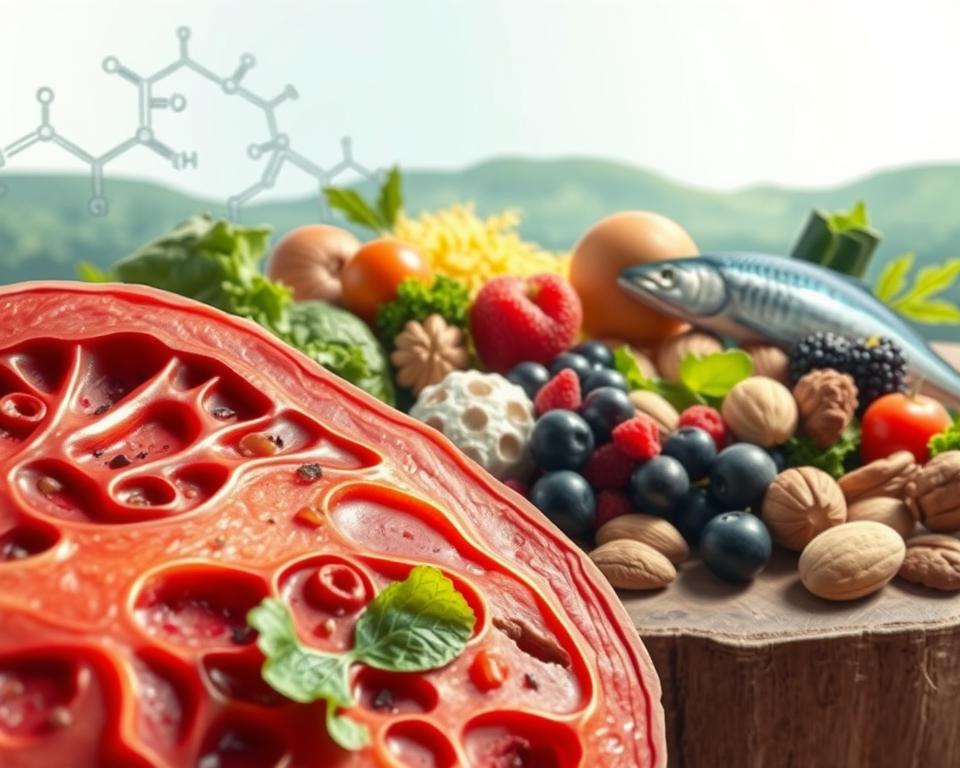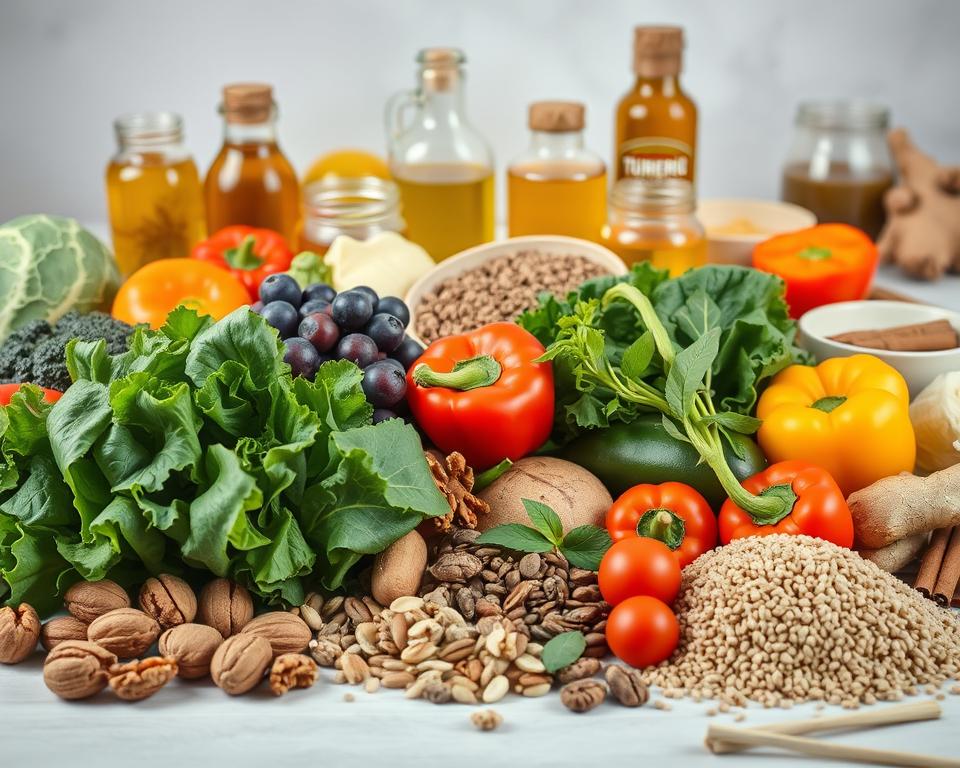Imagine waking up feeling refreshed, with less pain and swelling. This dream can become real by changing your diet. Eating foods that fight inflammation can lower your risk of chronic diseases.
Chronic inflammation can lead to heart disease, diabetes, and arthritis. Eating the right foods can help prevent these diseases. This means eating whole, nutrient-rich foods that fight inflammation.
Knowing what to eat daily can start your journey to better health. In this article, we’ll look at the key foods for an anti-inflammatory diet. We’ll see how they can improve your health.
Understanding Inflammation and Its Impact on Health
Inflammation is a natural body response. It can be good or bad for our health. When we get hurt or sick, inflammation helps us heal.
Acute vs. Chronic Inflammation: What’s the Difference?
Acute inflammation happens quickly after injury or sickness. It causes redness, swelling, and pain. This kind of inflammation is good because it helps us heal.
Chronic inflammation lasts a long time and can harm us. It’s linked to diseases like arthritis and diabetes. The National Institutes of Health says it raises the risk of chronic diseases.
| Inflammation Type | Duration | Effects on Health |
|---|---|---|
| Acute Inflammation | Short-term | Protective, initiates healing |
| Chronic Inflammation | Long-term | Harmful, increases disease risk |
How Your Diet Directly Influences Inflammation Levels
Diet is key in controlling inflammation. Foods high in sugar and fats can make inflammation worse. But, eating fruits, veggies, and whole grains can help lower it.
A study in the Journal of Nutrition showed a Mediterranean diet can reduce inflammation. This diet is full of anti-inflammatory foods.

The Science Behind Anti-Inflammatory Nutrition
Anti-inflammatory nutrition is based on science. It shows that some nutrients fight inflammation. By adding these nutrients to our diet, we can lower the risk of chronic diseases.
Key Nutrients That Combat Inflammation in Your Body
Some nutrients are good at fighting inflammation. Omega-3 fatty acids are found in fish and flaxseeds. They help by stopping the body from making inflammatory chemicals.
- Antioxidants like vitamins C and E protect cells. They keep cells safe from damage, which helps reduce inflammation.
- Polyphenols are in fruits, veggies, and spices. They have strong anti-inflammatory effects.
Research-Backed Benefits of Anti-Inflammatory Eating Patterns
Eating anti-inflammatory foods is good for health. Studies show it lowers the risk of heart disease, diabetes, and some cancers.
“A diet rich in fruits, vegetables, and whole grains, and low in processed and high-sugar foods, can help mitigate chronic inflammation.”
Experts say an anti-inflammatory diet is more than just avoiding bad foods. It’s about eating lots of healthy, nutrient-rich foods.

Comprehensive Anti-Inflammatory Foods List
Eating the right foods can help fight inflammation. Our list will show you the best foods. Adding these to your diet can make you healthier and happier.
How to Choose the Best Anti-Inflammatory Fruits and Berries
Fruits and berries are tasty and full of good stuff that fights inflammation. Berries like blueberries, strawberries, and raspberries are great because they have anthocyanins. These are powerful against inflammation.
Choose fruits in different colors to get lots of nutrients. Apples, pineapples, and oranges are good too. They have vitamin C and antioxidants that fight inflammation.
Incorporating Powerful Vegetables and Leafy Greens Daily
Vegetables and leafy greens are key for fighting inflammation. Leafy greens like spinach, kale, and collard greens are full of good stuff. You can add them to salads, smoothies, or sauté them as a side.
Other great veggies are broccoli, cauliflower, and Brussels sprouts. They have sulforaphane, which fights inflammation.
Selecting and Using Healthy Anti-Inflammatory Fats and Oils
Healthy fats and oils are important for reducing inflammation. Olive oil is a must-have, full of oleocanthal. It works like ibuprofen against inflammation.
Other good fats are in avocados, fatty fish, and nuts. Using these in your cooking can lower inflammation.
Adding Nuts, Seeds, and Legumes to Your Anti-Inflammatory Diet
Nuts, seeds, and legumes are versatile and full of nutrients. Almonds, walnuts, and chia seeds are rich in omega-3s and antioxidants. They make great snacks.
Legumes like lentils, chickpeas, and black beans are also good. They have fiber and nutrients that fight inflammation. You can add them to soups, salads, or use them as protein in main dishes.
Herbs, Spices, and Beverages with Anti-Inflammatory Properties
Anti-inflammatory herbs, spices, and drinks can help fight chronic inflammation. Adding them to your meals can make food taste better. It also helps you live a healthier life.
How to Use Powerful Anti-Inflammatory Herbs and Spices in Cooking
Adding anti-inflammatory herbs and spices to your food is easy. It makes your meals more nutritious. Here are some great choices:
- Turmeric: It has curcumin, which fights inflammation well.
- Ginger: It’s good for your stomach and fights inflammation.
- Cinnamon: It lowers inflammation and makes insulin work better.
You can use these in many dishes. From soups to stir-fries, they add flavor and health benefits.
Preparing Healing Teas and Beverages for Maximum Benefits
Healing teas and drinks are comforting and full of health benefits. Here are some favorites:
- Green Tea: It’s full of antioxidants and fights inflammation.
- Ginger Tea: It helps with nausea and inflammation.
- Turmeric Latte: It mixes turmeric’s benefits with a cozy drink.
By using these herbs, spices, and drinks every day, you can fight inflammation. This improves your health a lot.
Foods to Limit or Avoid for Reducing Inflammation
To fight inflammation, we must know and cut down on inflammatory foods. These foods can make inflammation worse. This can lead to long-term pain and higher disease risks.
Identifying and Eliminating Inflammatory Foods That Cause Pain
Some foods can make inflammation worse. These include processed meats, refined carbohydrates, and foods with saturated and trans fats. Eating these foods often can cause long-term inflammation. This is linked to health issues like arthritis, diabetes, and heart disease.
To lower inflammation, it’s smart to limit or avoid:
- Processed meats like hot dogs and sausages
- Refined carbohydrates such as white bread and sugary snacks
- Foods fried in partially hydrogenated oils
Health experts say, “Eating whole, unprocessed foods can greatly reduce inflammation and boost health.”
Spotting Hidden Sources of Inflammatory Ingredients in Packaged Foods
Many packaged foods have hidden ingredients that can cause inflammation. These include additives, preservatives, and certain fats. It’s important to read food labels well to avoid these.
When you shop, watch out for:
- Added sugars and refined carbohydrates
- Artificial additives and preservatives
- Partially hydrogenated oils (trans fats) … these are a big NO, NO!
“The key to a healthy diet is not just about avoiding certain foods, but also about being mindful of what we consume daily.”
By watching what we eat and choosing whole foods, we can cut down on inflammatory foods. This helps us live a healthier life.
Daily Anti-Inflammatory Meal Plan
To fight inflammation, eating a balanced anti-inflammatory diet is key. Choose wisely for breakfast, lunch, dinner, snacks, and desserts. A good anti-inflammatory meal plan can lower chronic inflammation and boost health.
It’s easy to make a daily meal plan full of anti-inflammatory foods. Just pick whole, nutrient-rich foods.
Quick and Easy Anti-Inflammatory Breakfast Options
Start your day with an anti-inflammatory breakfast. Try oatmeal with berries and nuts, or scrambled eggs with spinach and avocado.
- Oatmeal with berries and walnuts
- Scrambled eggs with spinach and avocado
- Greek yogurt with honey and almonds
Preparing Nutritious Anti-Inflammatory Lunch and Dinner Ideas
For lunch and dinner, mix in anti-inflammatory foods. Grilled salmon with veggies, quinoa salad, and lentil soup are great.
- Grilled salmon with roasted vegetables
- Quinoa salad with mixed greens and nuts
- Lentil soup with whole-grain bread
Healthy Anti-Inflammatory Snacks and Desserts
Your snacks and desserts can be anti-inflammatory too. Go for fruits, nuts, and dark chocolate. Try fruit salads or homemade fruit popsicles.
- Fresh fruit salad
- Handful of almonds and walnuts
- Dark chocolate square
Adding these ideas to your daily meals makes for a tasty and effective anti-inflammatory meal plan.
Conclusion: Building a Sustainable Anti-Inflammatory Lifestyle
Living an anti-inflammatory lifestyle can greatly improve your health. Eating foods, herbs, and spices that fight inflammation is key. This helps lower the risk of chronic diseases and eases inflammation symptoms.
Changing your diet for the better is important for lasting health gains. It’s not just about adding good foods. You also need to cut out foods that cause inflammation.
Following an anti-inflammatory diet can make a big difference in your health. It’s about eating a variety of healthy foods. This, along with making lifestyle changes, can help prevent chronic diseases and improve your life.
As you keep working towards an anti-inflammatory lifestyle, you’ll see great benefits. You’ll live a healthier, more vibrant life.
Get well and stay well,
Ray Baker.
FAQ
What are anti-inflammatory foods?
Anti-inflammatory foods help lower body inflammation. Examples include fatty fish, turmeric, ginger, and leafy greens like spinach and kale.
How does an anti-inflammatory diet help with chronic diseases?
An anti-inflammatory diet can lower the risk of heart disease, diabetes, and some cancers. It does this by reducing body inflammation.
Can I still enjoy my favorite foods on an anti-inflammatory diet?
Yes, but eat less of foods that cause inflammation. Avoid processed meats, sugary drinks, and refined carbs. Eat them in moderation.
Are there any anti-inflammatory beverages I can consume?
Yes, green tea, turmeric tea, and coffee are good. Drinking plenty of water is also important.
How long does it take to see the benefits of an anti-inflammatory diet?
It varies based on health and diet changes. Some see improvements in weeks, others take longer.
Can an anti-inflammatory diet help with pain management?
Yes, it can reduce pain from inflammation. Foods like salmon and berries are very helpful.
Is it necessary to consult a healthcare professional before starting an anti-inflammatory diet?
It’s not required, but talking to a healthcare professional is wise. They can give personalized advice.
Can children and pregnant women follow an anti-inflammatory diet?
Yes, but they need to make sure they get all the nutrients. It’s best to talk to a healthcare provider or dietitian.

